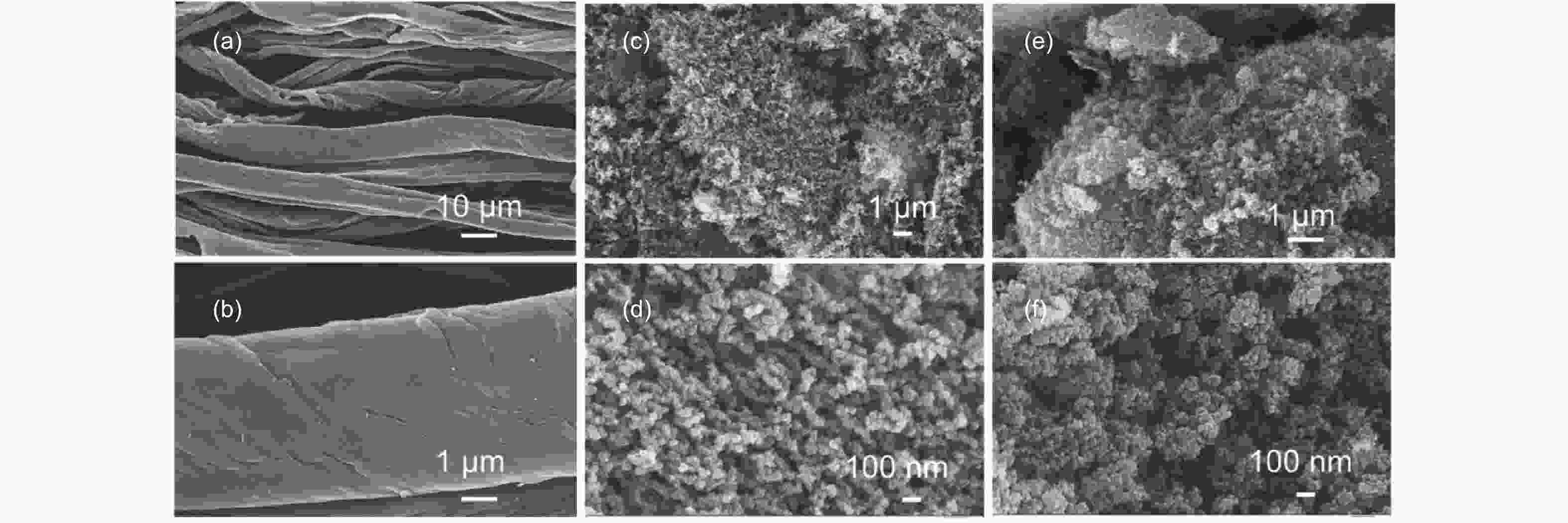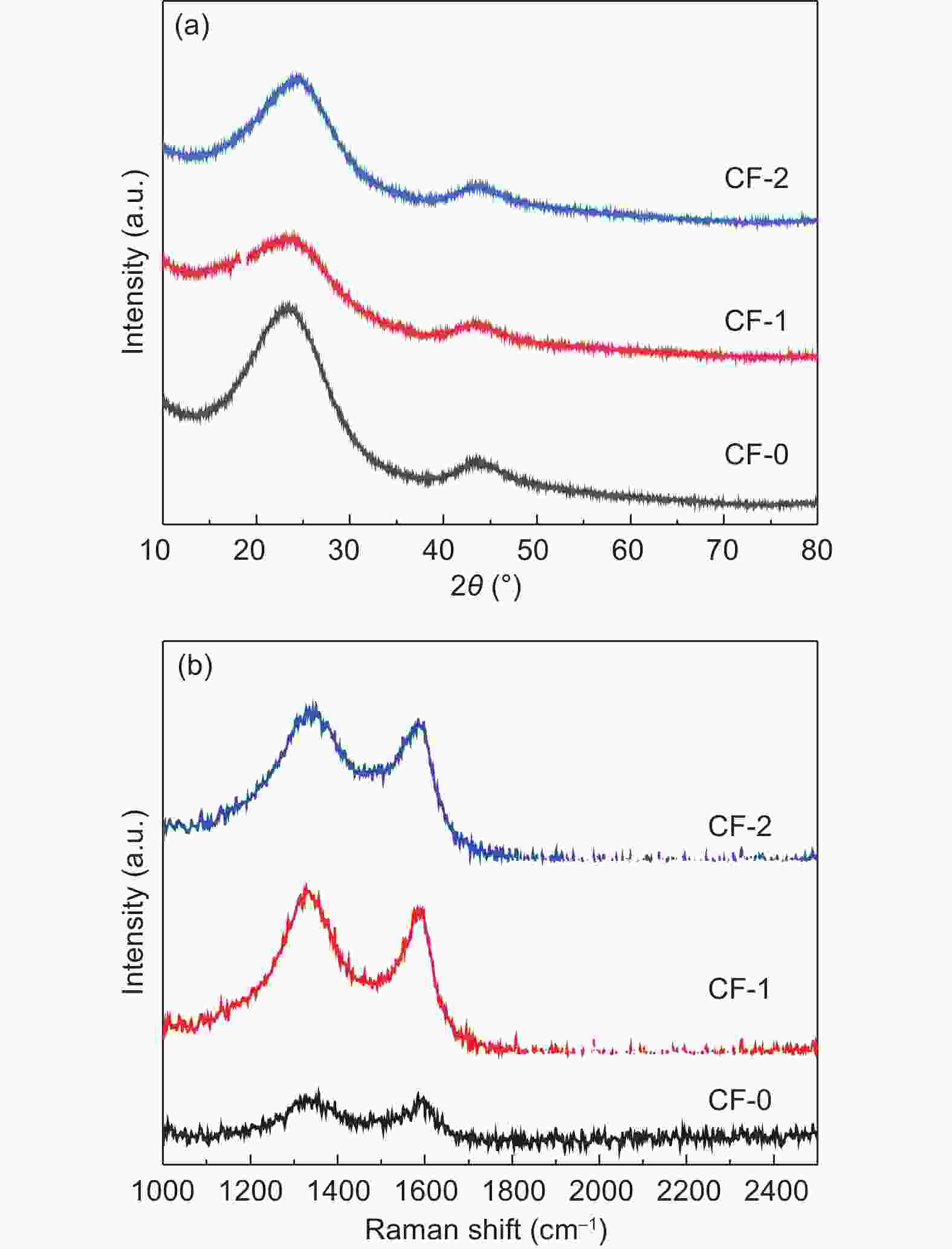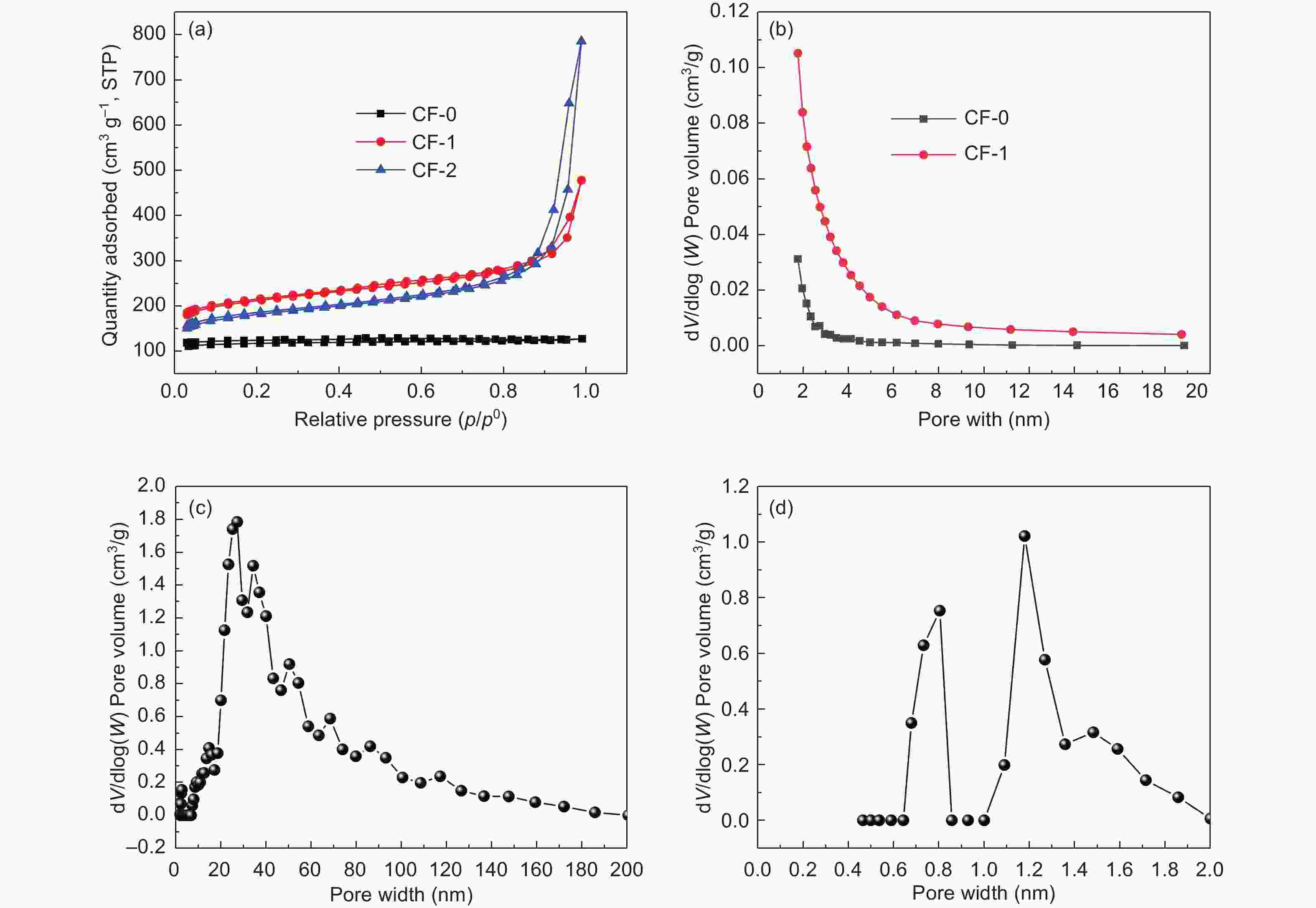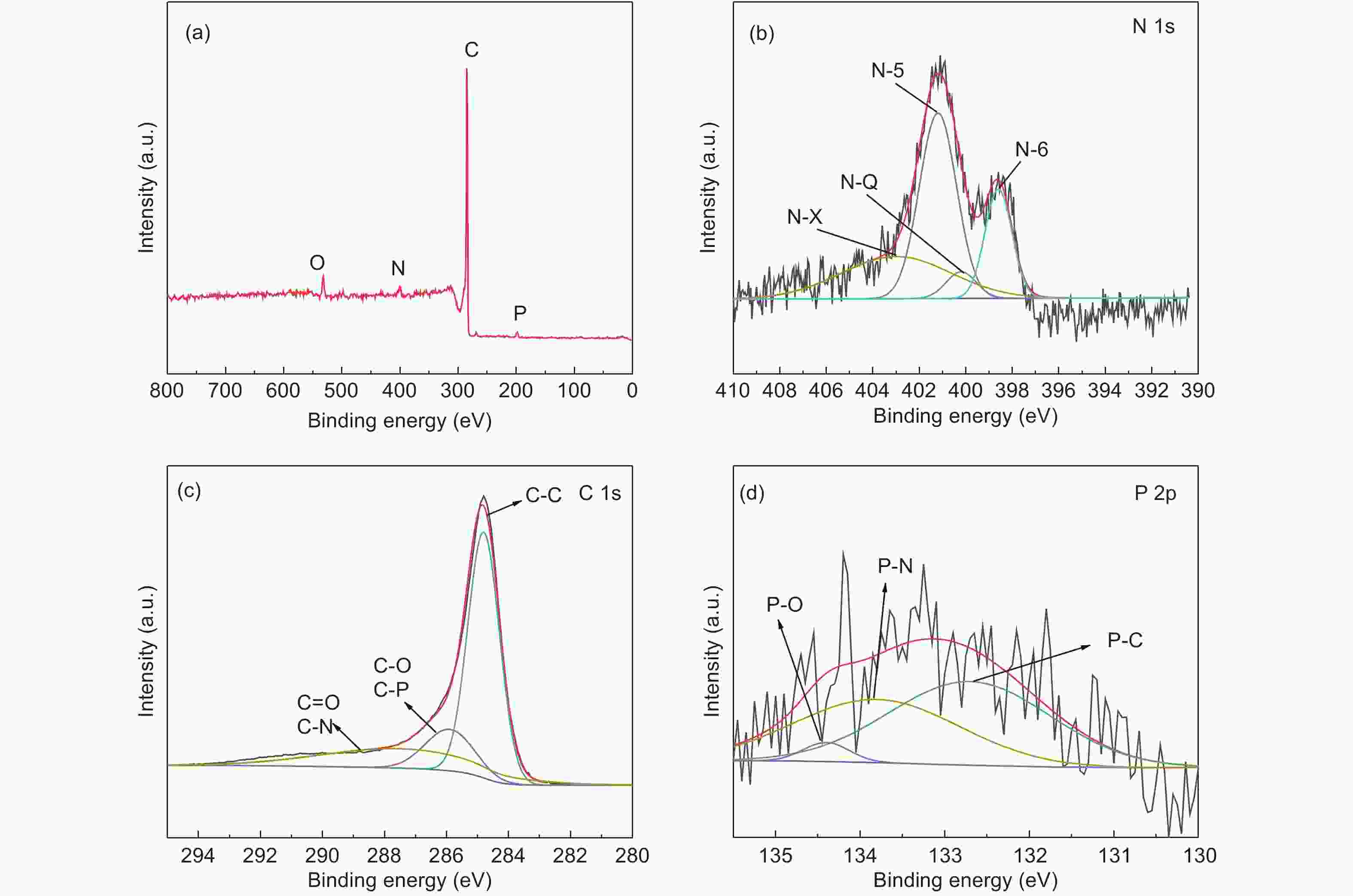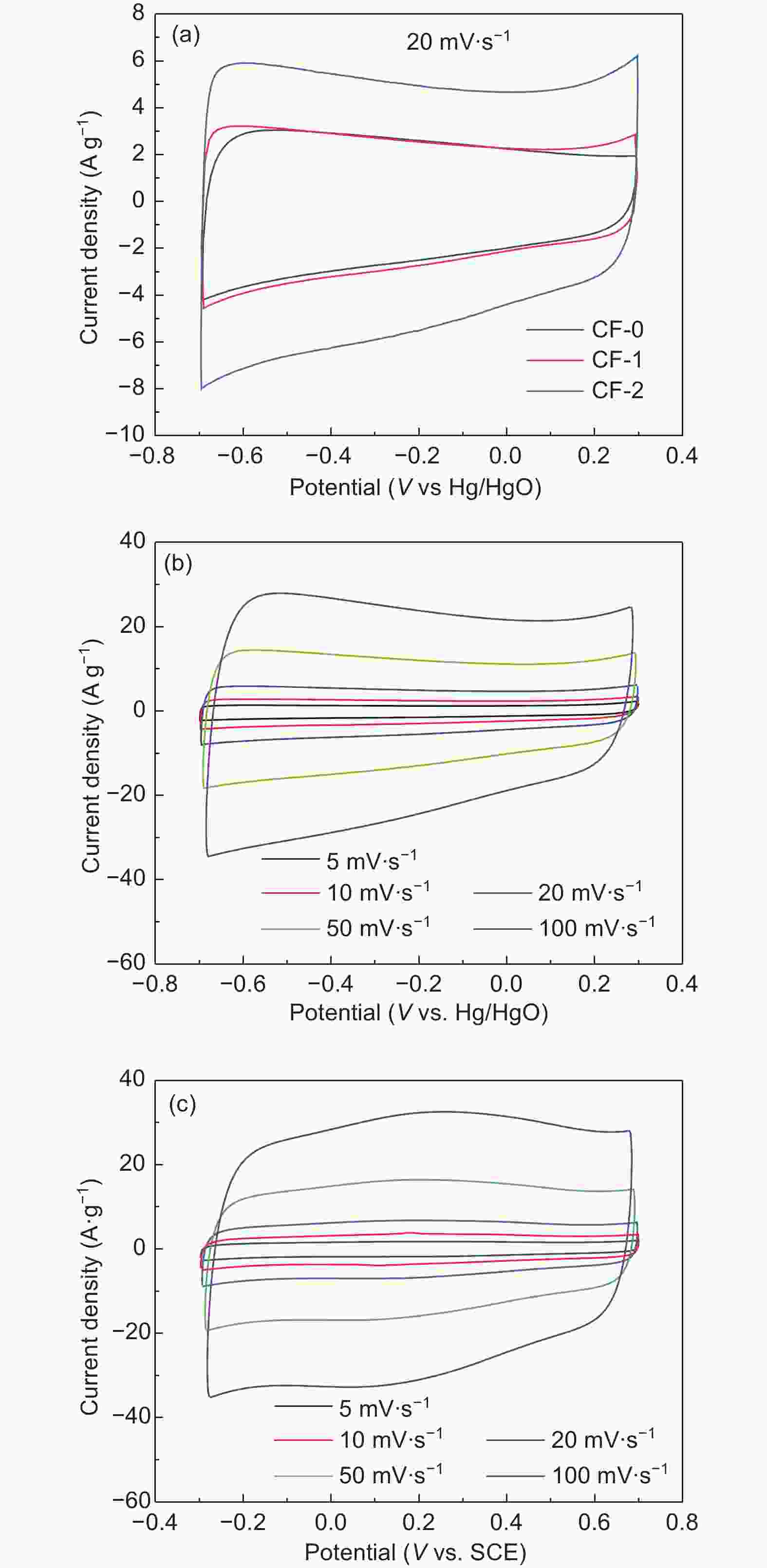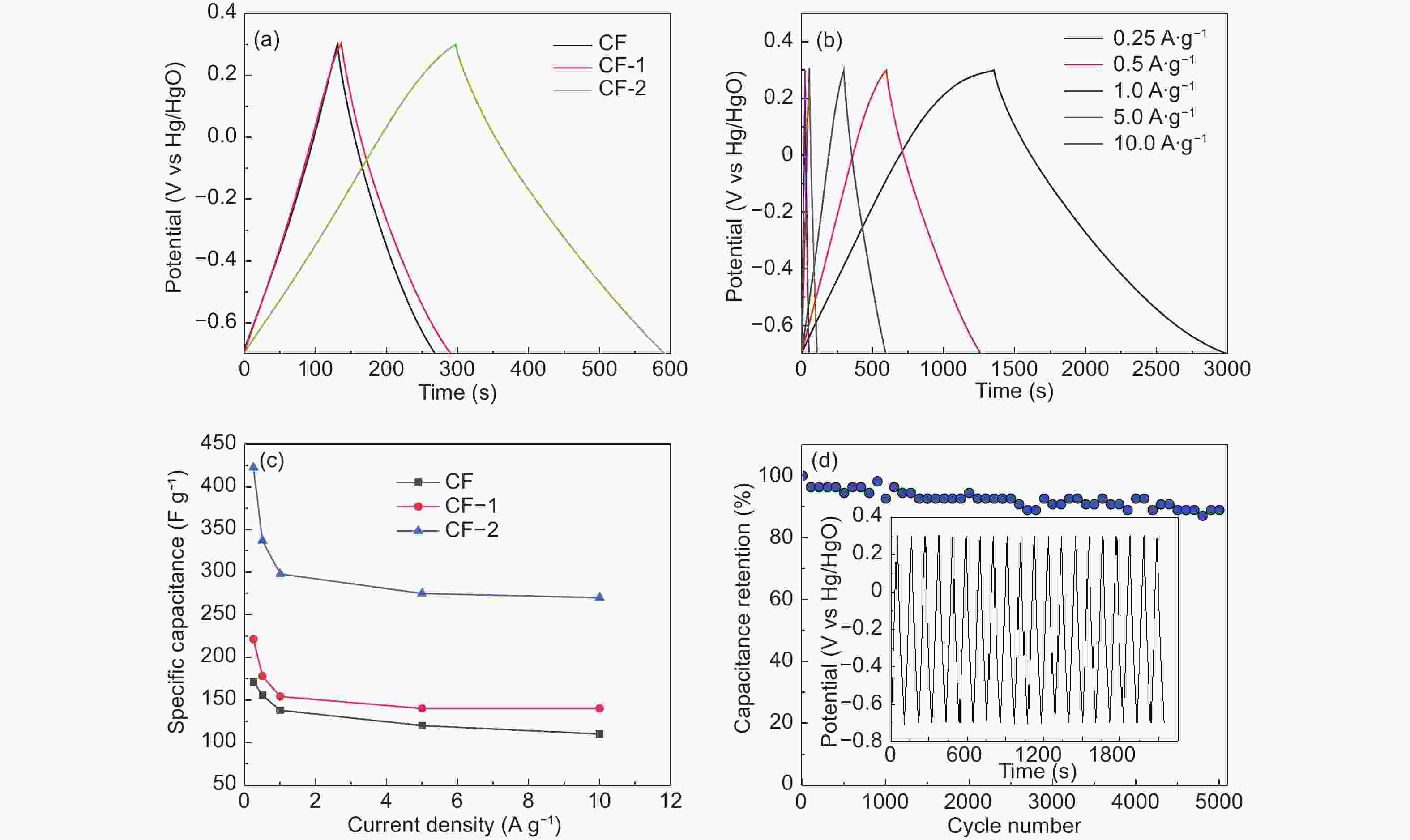Preparation of a N-P co-doped waste cotton fabric-based activated carbon for supercapacitor electrodes
-
摘要: 将废弃资源转化为能源储存材料是一种变废为宝,解决当前能源短缺、改善环境问题的新方向。本文采用熔盐一步炭化活化法,结合聚磷酸铵(APP)共掺杂技术,将废旧棉织物制备出氮/磷共掺杂的棉基活性炭材料。通过扫描电镜(SEM)、氮气吸附脱附仪(BET)、拉曼光谱仪(Raman)和X射线光电子能谱仪(XPS)对材料的形貌、结构和成分进行表征分析,同时使用循环伏安(CV)、恒流充放电(GCD)对材料的电化学性能进行测试。结果表明,将废旧棉织物与APP混合后,在ZnCl2/KCl熔盐介质中经炭化活化处理得到氮/磷共掺杂活性炭,BET比表面积为751 m2·g−1,在三电极体系中比电容高达423 F·g−1(电流密度为0.25 A·g−1时),在5 A·g−1的大电流密度下经5000圈循环后其容量保持率高达88.9%。同时,将其组装成对称型超级电容器时,在200 W·kg−1的功率密度下其能量密度为28.67 Wh·kg−1。这种将废弃棉织物资源转化为储能材料的方法成功实现了废弃纺织物的高附加值再利用。Abstract: Transforming waste resources into energy storage materials is a new way to convert them into value-added products and help solve the problems of energy shortage and environmental pollution. A nitrogen-phosphorus co-doped activated carbon was synthesized from waste cotton fabric by combining carbonization and activation in ammonium polyphosphate and a molten salt system (ZnCl2 and KCl with a molar ratio of 52∶48). The morphology, microstructure and composition of the activated carbon were characterized by SEM, nitrogen adsorption, Raman spectroscopy and XPS. Cyclic voltammetry and galvanostatic charge/discharge were used to test the supercapacitor performance of the activated carbon. Results show that the co-doped activated carbon had a specific surface area of 751 m2·g−1, a specific capacitance of 423 F·g−1 at a current density of 0.25 A·g−1, and a capacitance retention rate of 88.9% after 5 000 cycles at a current density of 5 A·g−1. The energy density was 28.67 Wh·kg−1 at a power density of 200 W·kg−1 for a symmetrical supercapacitor using the activated carbon.
-
Key words:
- Waste cotton fabric /
- Activated carbon /
- Nitrogen/phosphorous co-dopant /
- Supercapacitor
-
Table 1. BET surface area and pore structure characterization parameters of all samples.
Samples SBETa (m2∙g−1) Vtotalb (cm3∙g−1) Dc (nm) CF-0 350 0.032 2.846 CF-1 679 0.549 7.333 CF-2 751 1.372 20.32 Note: (a) BET specific surface area; (b) Total pore volume at p/p0 = 0. 99; (c) Average pore diameter -
[1] LUO Xian-you, CHEN Yong, MO Yan. A review of charge storage in porous carbon-based supercapacitors[J]. New Carbon Materials,2021,36(1):49-68. [2] Zhang Z, Wang L, Li Y, et al. Nitrogen-doped core-sheath carbon nanotube array for highly stretchable supercapacitor[J]. Advanced Energy Materials,2017,7(5):1601814. doi: 10.1002/aenm.201601814 [3] Ma Z, Zhang H, Yang Z, et al. Highly mesoporous carbons derived from biomass feedstocks templated with eutectic salt ZnCl2/KCl[J]. Journal of Materials Chemistry A,2014,2(45):19324-19329. doi: 10.1039/C4TA03829K [4] Wang X T, Ma H, He X J, et al. Fabrication of interconnected mesoporous carbon sheets for use in high-performance supercapacitors[J]. New Carbon Materials,2017,32(3):213-220. doi: 10.1016/S1872-5805(17)60118-5 [5] Zhang Q, Zuo S, Wei X. H3PO4 activated carbons as the electrode materials of supercapacitors using an ionic liquid electrolyte[J]. New Carbon Materials,2018,33(1):61-70. [6] Ma C, Shi J, Li Y, et al. Preparation of nitrogen-enriched porous carbon nanofibers and their electrochemical performance as electrode materials of supercapacitors[J]. 2015, (4): 295-301. [7] Lin T, Chen I W, Liu F, et al. Nitrogen-doped mesoporous carbon of extraordinary capacitance for electrochemical energy storage[J]. Science,2015,350(6267):1508-1513. doi: 10.1126/science.aab3798 [8] Huang X Z, Zhang X, Jiang H R, et al. Energy storage via polyvinylidene fluoride dielectric on the counterelectrode of dye-sensitized solar cells[J]. Journal of Power Sources,2014,248:434-438. doi: 10.1016/j.jpowsour.2013.09.094 [9] Chen J, Wei H, Chen H, et al. N/P co-doped hierarchical porous carbon materials for superior performance supercapacitors[J]. Electrochimica Acta,2018,271:49-57. doi: 10.1016/j.electacta.2018.03.129 [10] Xia K, Huang Z, Zheng L, et al. Facile and controllable synthesis of N/P co-doped graphene for high-performance supercapacitors[J]. Journal of Power Sources,2017,365:380-388. doi: 10.1016/j.jpowsour.2017.09.008 [11] Shang T X, Cai X X, Jin X J, et al. Phosphorus- and nitrogen-co-doped particleboard based activated carbon in supercapacitor application[J]. RSC Advances,2015,5(21):16433-16438. doi: 10.1039/C5RA00142K [12] Xu D, Tong Y, Yan T, et al. N, P-codoped meso-/microporous carbon derived from biomass materials via a dual-activation strategy as high-performance electrodes for deionization capacitors[J]. ACS Sustainable Chemistry & Engineering,2017,5(7):5810-5819. [13] Teo E Y L, Muniandy L, Ng E P, et al. High surface area activated carbon from rice husk as a high-performance supercapacitor electrode[J]. Electrochim Acta,2016,192:110-119. doi: 10.1016/j.electacta.2016.01.140 [14] Liu Y, Jin L, Xue B, et al. Preparation and electrochemical properties of rice husk based activated carbon modified by pitch[J]. Chemical Journal of Chinese Universities,2018,39(06):140-146. [15] Shang H, Lu Y, Zhao F, et al. Preparing high surface area porous carbon from biomass by carbonization in a molten salt medium[J]. RSC Advances,2015,5(92):75728-75734. doi: 10.1039/C5RA12406A [16] Guan L, Pan L, Peng T, et al. Synthesis of biomass-derived nitrogen-doped porous carbon nanosheests for high-performance supercapacitors[J]. ACS Sustainable Chemistry & Engineering,2019,7(9):8405-8412. [17] Inagaki M, Toyoda M, Soneda Y, et al. Morishita T nitrogen-doped carbon materials[J]. Carbon,2018,132:104-140. doi: 10.1016/j.carbon.2018.02.024 [18] Yang W, Yang W, Kong L, et al. Phosphorus-doped 3D hierarchical porous carbon for high-performance supercapacitors: A balanced strategy for pore structure and chemical composition[J]. Carbon,2018,127:557-567. doi: 10.1016/j.carbon.2017.11.050 [19] Zeng D, Dou Y, Li M, et al. J. Mater Wool fiber-derived nitrogen-doped porous carbon prepared from molten salt carbonization method for supercapacitor application[J]. Journal of Materials Science,2018,53(11):8372-8384. doi: 10.1007/s10853-018-2035-8 [20] Pérez-Madrigal M M, Edo M G, Alemán C, et al. Powering the future: Application of cellulose-based materials for supercapacitors[J]. Green Chemistry,2016,18(22):5930-5956. doi: 10.1039/C6GC02086K [21] Wei C, Yu J, Yang X, et al. Nanoscale activated carbon fibers with hierarchical nanostructure derived from waste cotton gloves as high-performance electrodes for supercapacitors[J]. Nanoscale Research Letters,2017,12(1):379. doi: 10.1186/s11671-017-2151-4 [22] Guo N, Li M, Sun X, et al. Enzymatic hydrolysis lignin derived hierarchical porous carbon for supercapacitors in ionic liquids with high power and energy densities[J]. Green Chemistry,2017,19(11):2595-2602. doi: 10.1039/C7GC00506G [23] Wang Y, Tian W, Wang L, et al. A tunable molten-salt route for scalable synthesis of ultrathin amorphous carbon nanosheets as high-performance anode materials for lithium-ion batteries[J]. ACS applied materials & interfaces,2018,10(6):5577-5585. [24] Wang Y, Liu J, Pan L, et al. Preparation of carbon nanosheets from petroleum asphalt via recyclable molten-salt method for superior lithium and sodium storage[J]. Carbon,2017,122:344-351. doi: 10.1016/j.carbon.2017.06.086 [25] Pampel J, Denton C, Fellinger T P. Glucose derived ionothermal carbons with tailor-made porosity[J]. Carbon,2016,107:288-296. doi: 10.1016/j.carbon.2016.06.009 [26] Tian W, Gao Q, Zhang L, et al. Renewable graphene-like nitrogen-doped carbon nanosheets as supercapacitor electrodes with integrated high energy-power property[J]. Journal of Materials Chemistry A,2016,4(22):8690-8699. doi: 10.1039/C6TA02828D [27] Xu G, Han J, Ding B, et al. Biomass-derived porous carbon materials with sulfur and nitrogen dual-doping for energy storage[J]. Green Chemistry,2015,17(3):1668-1674. doi: 10.1039/C4GC02185A [28] Niu J, Shao R, Liang J, et al. Biomass-derived mesopore-dominant porous carbons with large specific surface area and high defect density as high performance electrode materials for Li-ion batteries and supercapacitors[J]. Nano Energy,2017,36:322-330. doi: 10.1016/j.nanoen.2017.04.042 [29] Shang H, Zuo Z, Zheng H, et al. N-doped graphdiyne for high-performance electrochemical electrodes[J]. Nano Energy,2018,44:144-154. doi: 10.1016/j.nanoen.2017.11.072 [30] Wang H, Wang C, Dang B, et al. Nitrogen, sulfur, phosphorous co-doped interconnected porous carbon nanosheets with high defect density for enhancing supercapacitor and lithium‐ion battery properties[J]. Chem Electro Chem,2018,5(17):2367-2375. doi: 10.1002/celc.201800444 [31] Wang C, Zhou Y, Sun L, et al. Sustainable synthesis of phosphorus- and nitrogen-co-doped porous carbons with tunable surface properties for supercapacitors[J]. Journal of Power Sources,2013,239:81-88. doi: 10.1016/j.jpowsour.2013.03.126 [32] Huang C, Puziy A M, Poddubnaya O I, et al. Phosphorus, nitrogen and oxygen co-doped polymer-based core-shell carbon sphere for high-performance hybrid supercapacitors[J]. Electrochimica Acta,2018,270:339-351. doi: 10.1016/j.electacta.2018.02.115 [33] Zhang N, Liu F, Xu S D, et al. Nitrogen–phosphorus co-doped hollow carbon microspheres with hierarchical micro-meso-macroporous shells as efficient electrodes for supercapacitors[J]. Journal of Materials Chemistry A,2017,5(43):22631-22640. doi: 10.1039/C7TA07488C [34] Nasini U B, Bairi V G, Ramasahayam S K, et al. Phosphorous and nitrogen dual heteroatom doped mesoporous carbon synthesized via microwave method for supercapacitor application[J]. Journal of Power Sources,2014,250:257-265. doi: 10.1016/j.jpowsour.2013.11.014 [35] Lv B, Li P, Liu Y, et al. Nitrogen and phosphorus co-doped carbon hollow spheres derived from polypyrrole for high-performance supercapacitor electrodes[J]. Applied Surface Science,2018,437:169-175. doi: 10.1016/j.apsusc.2017.12.171 [36] Wang T, Zhang J, Hou Q. et al. Utilization of nutrient rich duckweed to create N, P Co-doped porous carbons for high-performance supercapacitors[J]. Journal of Alloys and Compounds,2019,771:1009-1017. doi: 10.1016/j.jallcom.2018.08.295 -





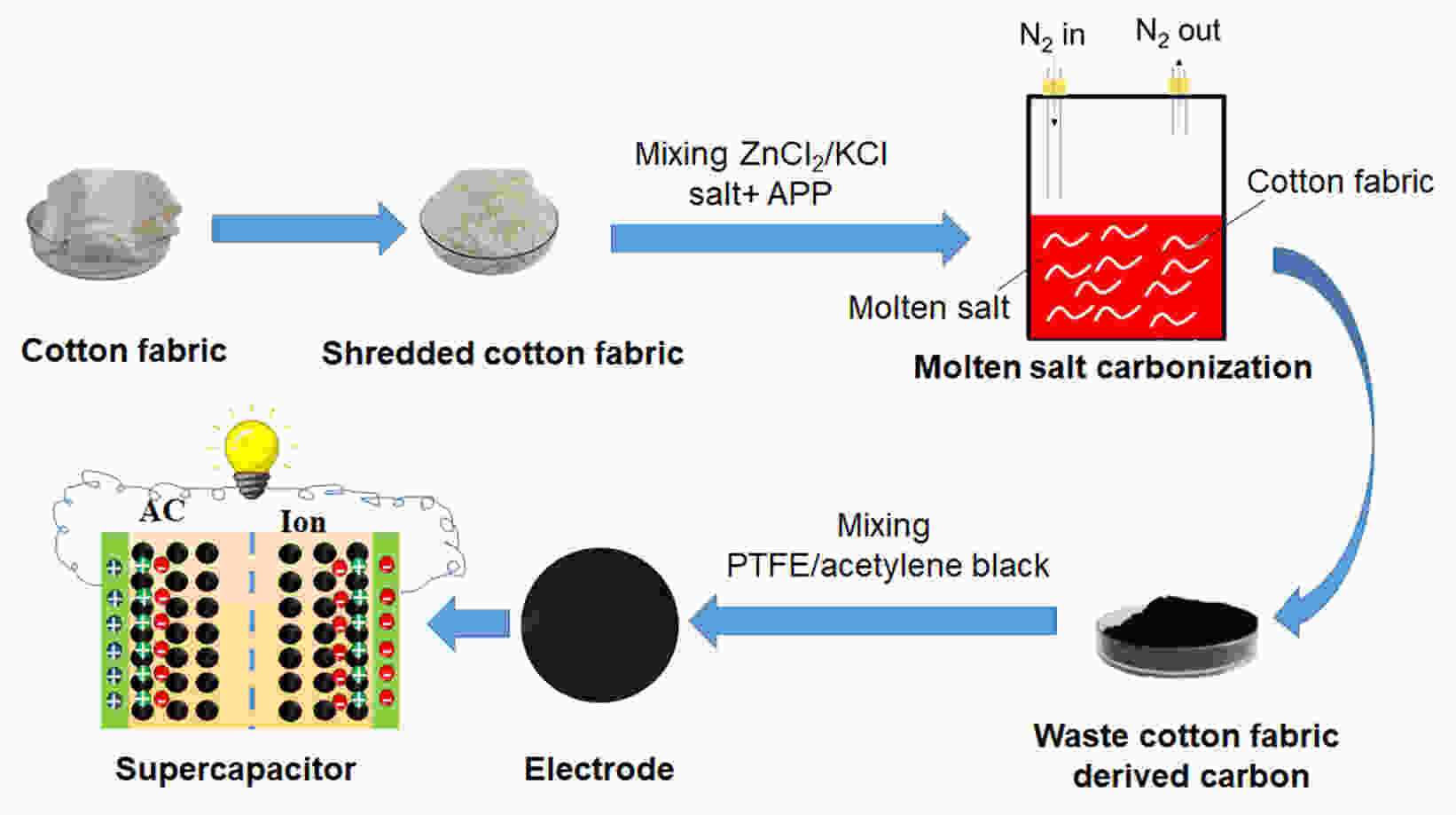
 下载:
下载:
